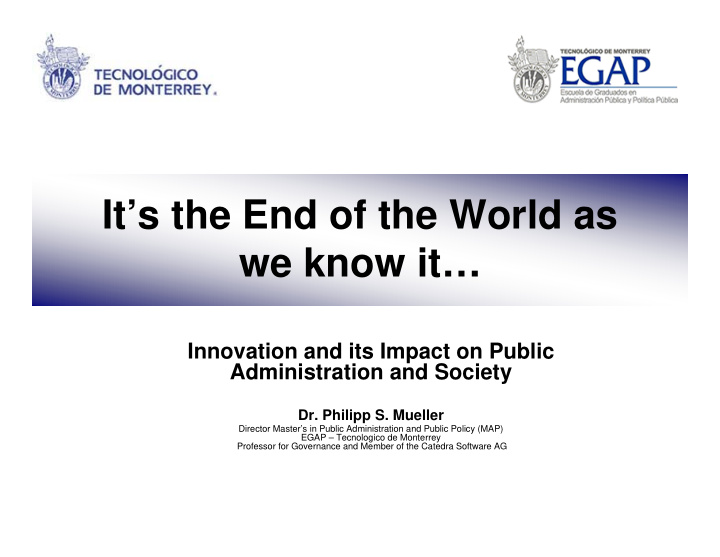



It’s the End of the World as we know it… Innovation and its Impact on Public Administration and Society Dr. Philipp S. Mueller Director Master’s in Public Administration and Public Policy (MAP) EGAP – Tecnologico de Monterrey Professor for Governance and Member of the Catedra Software AG
Shards of Glass... Picking up the Pieces Talking at events like this one Debating with people in Guanajato Thinking about the future of Mexican E-Gov with Funcion Publica Talking with Austrian Send Ideas to: government officials E-gob06- Time off at Harvard this 12@funcionpublica.gob. summer mx
Observation Innovation is transforming our worlds. The state is changing radically. Globalization is transforming our economies. Our societies are also transforming. And... Our lifeworld experiences are changing radically.
How can we connect these puzzle- pieces? We need to bring into the foreground the assumptions our thinking is based on. To construct a framework that allows us to explain the transformation in public administration and society. We need to draw a map of the new world we are moving into.
Main Stream Assumption about thinking about politics and society „Being Boring“ „The Real World“ Political Policy Empirical Theory Making Social Science
Alternative Assumption Our Focus Today!!! Political Policy Empirical Theory Making Social Science
Our World Academic Outside Observer Lifeworld Society World
Objects (rocks or food) World Change: Resources, Money
Concepts (like sovereignty, state, gender, Web 2.0, Secondlife, etc.) World Change: Ideas, Politics
How can we think about transformation? World World
How can we access this type of change?
Do you Dream in Orange? Foregrounding the Backgrounded We need an approach of dealing with the non-conceptualized (intuitive).
How can we access that what is backgrounded? How do backgrounds change through time?
Thinking Backgrounds in Metaphors A metaphor is something regarded as representative or suggestive of something else. It is the use of a familiar image to illuminate an unfamiliar idea, Example: Globalization as a Wave! experience, or process. Derived Policy Recommendation: States better learn to surf!
What aspects of metaphors should we focus on? The grammar of metaphors uncovers how imagery we use to explain and legitimize social life pre-structures the politics of social institutions. Metaphors that we use to explain and legitimize society and public administration change through time.
A Quick Tour Through History Metaphors to understand our worlds in different times
From Body Body to to Contract Contract: : Transcendence Transcendence to to From Immanence Immanence God Representatives Transformation of God‘s representative the State Citizens Immanent Institutional legitimation Transcendent legitimation
From Contract Contract to to Network Network: : Governance Governance not not From Government Government Government Governance Representative Transformation of problem Problem the State problem Solution Institution Solution (State) Problem Stakeholders Citizens Outcome legitimation Institutional legitimation
How are they different? Transcendent Immanent- Results-oriented institutional (2000+) (-1600) (-2000) Foundation God The State The Result Argument God said so. At some point in the I see and accept the past, we decided result. upon a common rule book/institution. Metaphor Body Contract Network It is good at: stability mobility result Nature: One-with-nature Controlling nature de-naturalized, disembodied Bias towards the Collective Individual collective or the individual Where is the power? God‘s representative government Consensus of stakeholders Last decider? God citizens stakeholders
What persuades us changes through time... But stays with us Persuasiveness 1600 2000
So what does Network Society look like? ...moving to the city For examples look at any web 2.0 application like: Secondlife, di.licio.us, Flickr, Xing, youtube, etc. But also look at yourself!!!
Principles of Network Society 1. The Technology Principle : Network Society is mediated through technology. 2. The Path Dependency Principle : Path dependency makes it costly for us to exercise choice and leave any given network. 3. The Scale and Network Effects Principle : Network effects are the glue of network society. 4. The Choice Principle : Any network participant chooses to participate or to leave at any point in time. 5. The Consensus Principle : Decisions in choice-communities are made by consensus (not unanimity …and forking allowed) 6. The Transparency Principle : Transparency takes the role of democracy as the standard against which any governance situation is evaluated. 7. The Outcome Legitimacy Principle : The legitimacy of a policy that aims to create public value is derived from the public value created (as defined by its stakeholders choice to stay-or-leave) 8. The Reflexive Governance Principle : The term governance assumes that the right of any participant in any decision-making situation needs to be reflected at all times (who participates in the consensus?).
Deriving Policy Recommendations from Theory Political Theory: Governance in Network Society ? Empirical The Real World: Public Administration, Social Science Society, Lifeworlds.
Network Policy Design Principles Think any policy from the result backwards. Govern- Civil Private Society sector Map the policy network ment across sectors and levels. Build consensus. Develop accountability systems. Document and make all processes transparent. Reflect what you are Impact doing? – Go back to square one. Input Process Output Outcome
Some Substantive Policy Recomendations... Can we Think of More? Focus on robust Software Ecosystem (open vs. proprietary code). Ensure balanced Intellectual Property Rights Regime. Introduce Network Technology in Basic Education. Get the kids online!!!! Take the Mexican Nation online. Implement Citizen Relationship Management on all levels of government. Develop public internet access projects (municipal wireless).
Lifeworld Recommendations Ajax, Mashups, leapfrogging, social entrepreneurship, create New worlds, open source your life,...
Conclusion The world is changing radically as we are moving from contract to network society. Network society does not displace contract society, however, it changes the power of legitimizing arguments. Understanding network society can help us design guiding principles for networked policy making. Understanding network society can help us design guiding principles for our networked lifes.
Thank you! philipp@itesm.mx PS: Do think about our Master‘s in Public Administration and Public Policy
Recommend
More recommend